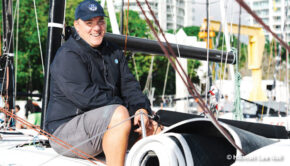How to Lose, And How Not To
Published on May 17th, 2021
Consider some old-school advice on easy ways to finish well by not making these simple mistakes. Report by Chris Snow for Sailing World.
Tom King is one of the best sailors in the world, yet most folks in the United States have probably never heard of him. Before winning the 2012 Etchells Worlds (as part of a Corinthian team), he won the 2000 470 Worlds and an Olympic Gold medal in the 470 when it was held in his hometown of Sydney, Australia, that same year.
About five years ago, I was helping run a clinic with Chris Busch, one of the top sailors in our San Diego Etchells fleet, and Tom’s name came up when Chris shared a document Tom wrote titled “Racecraft.” It included Tom’s top-10 list of ways to ensure you won’t finish in the top of the fleet.
I reached out to Tom and asked him to explain how he developed his top-10 list. Tom said his inspiration was the late, longtime Sailing World columnist, Dr. Stuart Walker. He shared with me a photocopy of an article Dr. Walker had written for the magazine Australian Sailing, which prompted him to write his own notes for his local fleet.
With full credit to Tom and a tip of the hat to the late Dr. Stuart Walker, here’s my top-10 list of how to ensure you won’t finish at the top of the fleet—and what you can do about it.
Starting where you won’t be able to be on/stay on the correct tack right after the start
• Focus on starting in low-density areas near the area you want to start.
• Avoid high-risk starts whenever possible (like at the pin).
• Practice being at full speed, on the line, at the gun.
Sailing in a position where others are slowing you down
• If you’re in bad air at the start, or even before, tack immediately to get to clear air, and then get onto the favored tack as soon as possible.
• The act of ducking behind starting boats increases your speed relative to them often resulting in little loss.
• Packs of boats tend to go slower than boats that are free to sail where they want—avoid the packs.
• If you think you are in bad air, you probably are. Tack to clear and then come back.
• Know that when the shifts are very big and short-lived, like you might experience on a lake, it might be better to stay on the lifted tack in bad air than tack.
Full report… click here.









 We’ll keep your information safe.
We’ll keep your information safe.